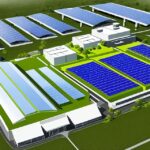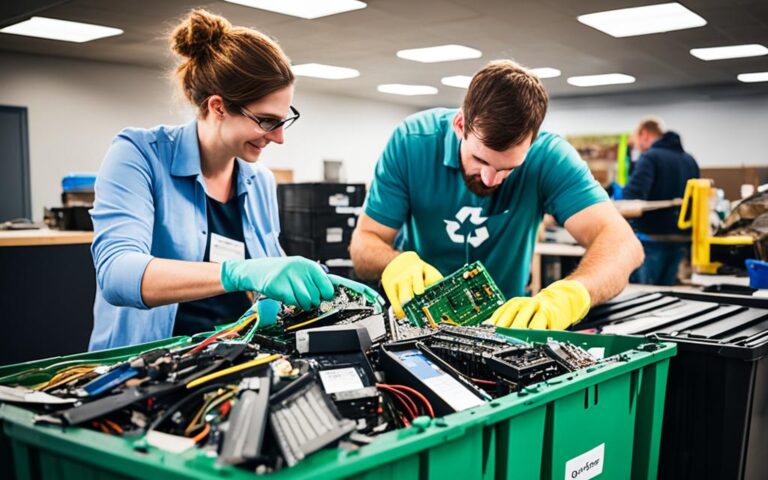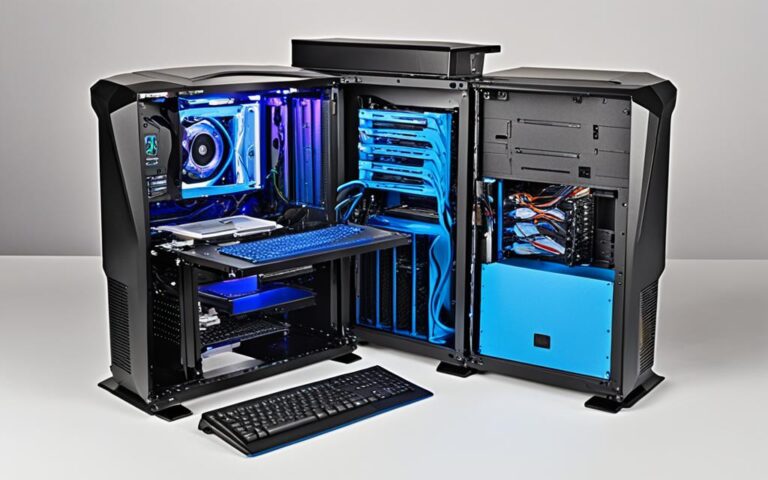Green Computing Recycling: Bridging Technology and Ecology
Welcome to the world of Green Computing, a transformative approach that seeks to harmonize the realms of technology and ecology. In a time when environmental concerns are at the forefront, the concept of Green Computing has emerged as a crucial solution to minimize the ecological impact of information technology. By optimizing energy efficiency and embracing recycling practices, Green Computing aims to pave the way for a sustainable digital future. This article will delve into the intricacies of Green Computing and explore its significance in the context of technology and ecology.
Green Computing, also known as Green IT or Sustainable Computing, has been a pressing issue since the early 1990s when the energy consumption of computers first became a concern. In response, initiatives like the Energy Star program were introduced to promote energy-efficient devices and reduce power consumption. Today, Green Computing encompasses various strategies, including energy efficiency, renewable energy adoption, responsible e-waste management, and server virtualization.
Implementing Green Computing, however, is not without challenges. The costs associated with transitioning to green technologies can be a hurdle for many organizations. Furthermore, lack of awareness about the environmental impact of digital activities and resistance to change can pose obstacles. Nevertheless, the numerous benefits of Green Computing, such as enhanced energy efficiency and reduced carbon footprint, make it a cause worth pursuing.
By embracing Green Computing, we can bridge the gap between technology and sustainability. It allows us to use the power of innovation and digitalization to safeguard the planet we inhabit. Through conscious consumption, responsible recycling, and the adoption of energy-efficient practices, we can create a greener and more prosperous future for all. Join us as we explore the exciting world of Green Computing and its role in shaping a sustainable digital landscape.
Learn more about server recycling in the UK
The Evolution of Green Computing
The evolution of Green Computing can be traced back to the early 1990s when the energy consumption of computers first gained attention. As personal computers became more prevalent, energy efficiency became a priority for manufacturers and users. The Energy Star program, introduced in 1992, played a significant role in promoting energy-efficient computers and reducing power consumption.
“The Energy Star program is a voluntary labeling program designed to identify and promote energy-efficient products to reduce greenhouse gas emissions. It has made a significant impact in raising awareness and driving the adoption of energy-efficient technologies in the computer industry.” – Jane Thompson, Environmental Scientist
Over the years, Green Computing has evolved as technology advanced, with a focus on maximizing energy efficiency and minimizing environmental impact in the design and use of computer chips, systems, and software. Today, companies are actively incorporating green practices throughout the lifecycle of their products, from manufacturing to end-of-life disposal.
Green Computing Milestones
- 1992: Introduction of the Energy Star program
- 1996: United Nations World Summit on Sustainable Development highlights the importance of sustainable technology
- 2007: The first Green500 list is published, ranking the most energy-efficient supercomputers
These milestones have played an instrumental role in driving innovation and creating a shift towards greener computing practices.
Energy-Efficient Design
The evolution of Green Computing has seen significant advancements in energy-efficient design. Manufacturers now prioritize the development of low-power components and optimize power management features. This ensures that devices consume minimal energy during operation and standby modes, reducing their overall environmental impact.
Software and System Optimization
In addition to hardware improvements, software and system optimization play a vital role in energy efficiency. Operating systems and applications are continuously being designed to minimize resource consumption and improve performance. Virtualization technology enables the consolidation of multiple virtual servers onto a single physical server, reducing energy consumption and hardware requirements.
Environmental Impact Assessment
Environmental impact assessments have become an integral part of the Green Computing evolution. As technology advances, manufacturers are increasingly considering the entire lifecycle of their products, including the sourcing of raw materials, manufacturing processes, and end-of-life disposal. By evaluating the environmental impact throughout the entire product lifecycle, companies can implement more sustainable practices.
| Year | Green Computing Focus |
|---|---|
| 1997 | Energy-efficient power supplies introduced |
| 2005 | EPEAT (Electronic Product Environmental Assessment Tool) certification program established |
| 2010 | Green Grid’s Power Usage Effectiveness (PUE) metric introduced for data center energy efficiency |
The continuous evolution of Green Computing is driven by the increasing awareness of the environmental impact of technology and the need for sustainable solutions. As society becomes more eco-conscious, the focus on energy efficiency, renewable energy, and responsible e-waste management will continue to shape the future of Green Computing.
Green Computing Strategy
A successful Green Computing strategy encompasses various aspects aimed at minimizing the environmental impact of information technology. By incorporating energy efficiency, renewable energy sources, responsible e-waste management, and virtualization, organizations can make significant strides towards a greener and more sustainable digital future.
Energy Efficiency
One key element of a Green Computing strategy is optimizing energy efficiency. Devices and data centers can be designed to consume less power by implementing hardware optimizations and adopting low-power modes. This includes the use of energy-efficient components and power management techniques to reduce overall electricity consumption.
Renewable Energy
Transitioning to renewable energy sources is another crucial aspect of sustainable computing. By harnessing solar, wind, or other renewable energy options to power data centers, organizations can significantly reduce their carbon footprint. Embracing renewable energy aligns with the goals of green computing and supports the overall objective of minimizing environmental impact.
E-Waste Management
Responsible disposal and recycling of electronic waste is essential for a comprehensive Green Computing strategy. This involves extending the lifespan of devices through proper maintenance and upgrades, as well as recycling components to minimize waste. Safe disposal of hazardous materials ensures that e-waste does not harm the environment or pose health risks to individuals.
Virtualization
Server virtualization and cloud computing play a vital role in minimizing the physical infrastructure needed for IT operations. By consolidating hardware resources and using virtual servers, organizations can reduce the number of physical machines and data centers required. This not only saves space but also reduces power consumption, contributing to energy efficiency and sustainability.
Implementing a Green Computing strategy is an integral part of a company’s environmental responsibility. By prioritizing energy efficiency, embracing renewable energy, practicing responsible e-waste management, and leveraging virtualization technologies, organizations can make a significant positive impact on the environment and contribute to a greener future.
| Green Computing Strategy Elements | Benefits |
|---|---|
| Energy Efficiency | Reduces electricity consumption |
| Renewable Energy | Minimizes carbon footprint |
| E-Waste Management | Prevents environmental harm |
| Virtualization | Saves space and reduces power consumption |
Challenges to Implementing Green Computing
Implementing Green Computing is not without its challenges. Organizations face several obstacles when considering the adoption of green technologies.
1. Costs
One of the main hurdles is the financial aspect. The implementation of green technologies and practices can be costly. Investing in energy-efficient hardware, renewable energy sources, and responsible e-waste management requires a significant upfront investment for organizations. While the long-term cost savings may balance out the initial expenditure, the perceived high costs can deter some businesses from embarking on a green computing journey.
2. Lack of Awareness
Another challenge is the lack of awareness about the environmental impact of digital activities and the steps that can be taken to reduce it. Many organizations are not fully aware of the energy consumption of their IT infrastructure and the potential for energy savings. Without this knowledge, businesses may not prioritize green computing efforts and miss out on the benefits it offers.
3. Resistance to Change
Transitioning to more energy-efficient technologies can face resistance, particularly when existing infrastructure and systems are deeply ingrained. Resistance to change can stem from various factors, such as concerns about compatibility, the need for retraining staff, and the fear of disrupting established workflows. Overcoming this resistance requires effective change management strategies, clear communication, and demonstrating the benefits of green computing in terms of energy efficiency and environmental sustainability.
Despite these challenges, the advantages of Green Computing in terms of energy efficiency, cost savings, and environmental responsibility make it a worthwhile pursuit for organizations. By addressing these challenges head-on, businesses can contribute to a greener future while achieving their own sustainability goals.
| Challenges | Impact |
|---|---|
| Costs | Financial burden on organizations, potential upfront investment required |
| Lack of Awareness | Minimal understanding of energy consumption and potential energy savings |
| Resistance to Change | Fear of disrupting established infrastructure and workflows |
Conclusion
Green Computing is a crucial concept that holds the key to a sustainable digital future. It necessitates the collaboration of manufacturers, organizations, and individuals in mitigating the environmental impact of information technology. By embracing energy efficiency, renewable energy sources, responsible e-waste management, and conscious consumption, we can pave the way for a greener and more sustainable digital world. Green Computing allows us to bridge the gap between technology and sustainability, ensuring that our technological advancements do not come at the expense of the planet.
Through the implementation of energy-efficient practices and the utilization of renewable energy sources, we can significantly minimize our carbon footprint. Additionally, responsible e-waste management, including device lifespan extension, component recycling, and proper disposal of hazardous materials, is crucial in safeguarding the environment.
As individuals and organizations, we have an ecological responsibility to embrace Green Computing practices and be mindful of our technological choices. By collectively working towards a more sustainable future, we can create a digitized, greener, and more prosperous world for all. Technology and sustainability can go hand in hand when ecological responsibility becomes a priority.
FAQ
What is Green Computing?
Green Computing, also known as Green IT or Sustainable Computing, aims to maximize energy efficiency and minimize the environmental impact of information technology.
When did the concept of Green Computing emerge?
The concept of Green Computing traces back to the early 1990s when energy consumption of computers became a concern.
What is the Energy Star program?
The Energy Star program, introduced in 1992, marked a significant milestone in promoting energy-efficient computers and reducing power consumption.
What elements are involved in a successful Green Computing strategy?
A successful Green Computing strategy involves elements such as energy efficiency, renewable energy, e-waste management, and virtualization.
How can energy efficiency be achieved in Green Computing?
Energy efficiency can be achieved by optimizing hardware components and adopting low-power modes in devices and data centers.
How can renewable energy be incorporated into Green Computing?
Transitioning to renewable energy sources, such as solar or wind, for powering data centers can significantly reduce their carbon footprint.
What is the importance of e-waste management in Green Computing?
Responsible disposal and recycling of electronic waste is crucial in minimizing the environmental impact of IT, involving extending the lifespan of devices, recycling components, and safely disposing of hazardous materials.
How can virtualization contribute to Green Computing?
Server virtualization and cloud computing can consolidate hardware resources, reducing the need for physical servers and data centers.
What challenges are faced in implementing Green Computing?
Challenges in implementing Green Computing include costs, lack of awareness about the environmental impact, and resistance to transitioning to more energy-efficient technologies.
Is Green Computing worth pursuing despite these challenges?
Yes, the benefits of Green Computing in terms of energy efficiency and environmental sustainability make it worth pursuing.
How does Green Computing contribute to a sustainable digital future?
Green Computing is an essential paradigm for a sustainable digital future as it reduces the environmental impact of IT through energy efficiency, renewable energy sources, responsible e-waste management, and conscious consumption.













